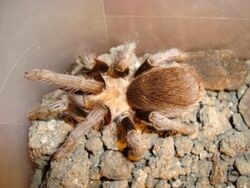Biology:Texas brown tarantula
| Aphonopelma hentzi | |
|---|---|

| |
| Scientific classification | |
| Domain: | Eukaryota |
| Kingdom: | Animalia |
| Phylum: | Arthropoda |
| Subphylum: | Chelicerata |
| Class: | Arachnida |
| Order: | Araneae |
| Infraorder: | Mygalomorphae |
| Family: | Theraphosidae |
| Genus: | Aphonopelma |
| Species: | A. hentzi
|
| Binomial name | |
| Aphonopelma hentzi (Girard, 1852)
| |
| Synonyms[1] | |
| |
The Aphonopelma hentzi, also known as Texas brown tarantula, Oklahoma brown tarantula, or Missouri tarantula,[2] is one of the most common species of tarantula living in the Southern United States today. Texas brown tarantulas can grow to leg spans in excess of 10 cm (4 in),[3] and weigh more than 85 g (3 oz) as adults. Their bodies are dark brown, though shades may vary between individual tarantulas. The colors are more distinct after a molt, as with many arthropods.
Lifecycle
A female of A. hentzi can lay up to 1,000 eggs.[4] The eggs are positioned securely in a web shaped like a hammock,[4] which remains in her burrow, and guarded by her. Eggs hatch in 45 to 60 days. Once spiderlings leave the egg sac, they often stay with the female for several days before dispersing to make their own burrows.
Females have been known to live up to 40 years.[5][6] However, no studies have lasted this long, so their lifespan may be longer. Males rarely live over a year after they have matured.
Defense
A. hentzi is a rather docile and nonaggressive species.[7][8] When disturbed, like most other tarantulas, A. hentzi maneuvers itself to a stance on its hind legs and raises its front legs in a threatening manner. Additionally, A. hentzi and most other tarantulas found in the Americas have small, coarse, brown or black urticating hairs on their abdomens that they kick in the direction of whatever they may feel threatens them. It is the main species preyed upon by the tarantula hawk, Pepsis grossa, in areas where the two species overlap.[9]
Bites from the Texas brown tarantula, as with all New World tarantulas, are generally not a serious harm to humans except in the case of an allergic reaction.[10] Due to the large size of their fangs, the puncture wound from a bite can also be painful and lead to secondary infection if not properly treated.
Distribution
The distribution of A. hentzi includes Colorado, Kansas, Missouri, New Mexico, Oklahoma, Arkansas, Texas, and Louisiana in the U.S. The species has also been documented in the northern parts of Mexico, extending along the New Mexico and Texas borders.[11][2][12][13]
Habitat
A. hentzi is a terrestrial species commonly found in grasslands, burrowed underground, or using logs, stones, or other small animals' abandoned dens as their homes and feeding grounds.[14] Texas brown tarantulas use their spinnerets to line the entrance of their shelters with webbing to detect passing prey.
References
- ↑ Hamilton, C.A.; Hendrixson, B.E.; Bond, J.E. (2016), "Taxonomic revision of the tarantula genus Aphonopelma Pocock, 1901 (Araneae, Mygalomorphae, Theraphosidae) within the United States", ZooKeys (560): 1–340, doi:10.3897/zookeys.560.6264, PMID 27006611
- ↑ 2.0 2.1 "Spiders: Tarantula". University of Missouri. 1993–2011. http://extension.missouri.edu/publications/DisplayPub.aspx?P=g7386-7. Retrieved January 21, 2011.
- ↑ Oklahoma Brown Tarantula RET. Nov. 20, 2107 22:37 CST
- ↑ 4.0 4.1 "Aphonopelma Hentzi - Texas Brown Tarantula". 6 September 2020. https://usaspiders.com/aphonopelma-hentzi-texas-brown-tarantula/.
- ↑ How to Care for a Texas Brown Tarantula RET. Nov 20, 2017 23:16 CST.
- ↑ Texas Brown Tarantula RET. Nov. 20, 2017, 23:27 CST.
- ↑ Oklahoma Brown Tarantula RET. Nov.20 2017
- ↑ Animal-World. "Oklahoma Brown Tarantula" (in en-us). https://animal-world.com/encyclo/reptiles/spiders/OklahomaBrownTarantula.php.
- ↑ Vardy, C.R. (2000). "The New World tarantula-hawk wasp genus Pepsis Fabricius (Hymenoptera: Pompilidae). Part 1. Introduction and the P. rubra species-group". Zoologische Verhandelingen 332: 1–86. https://repository.naturalis.nl/document/46285.
- ↑ "A Word about Tarantula Bites". Tom's Big Spiders. 24 July 2015. https://tomsbigspiders.com/2015/07/24/tarantula-bites/.
- ↑ Texas Brown Tarantula RET. NOV. 20, 2017 22:32 CST
- ↑ "Redefining the Type Locality and Range of the Tarantula, Aphonopelma hentzi". Aphonopelma: Tarantulas of the United States. August 9, 2010. http://aphonopelma.wordpress.com/2010/08/09/redefining-the-type-locality-and-range-of-the-tarantula-aphonopelma-hentzi/. Retrieved January 21, 2011.
- ↑ Aphonopelma hentzi (Girard 1852), female, Denver, Colorado, USA - Tarantulas, Bird Spiders - Rick West, Arachnologist
- ↑ Oklahoma Brown Tarantula RET. NOV. 20, 2017.
- Marshall, Samuel D. (2001). Tarantulas and Other Arachnids. Barron's. ISBN 0-7641-1463-8.
External links
- canadianarachnology.org: Aphonopelma hentzi - Texas Brown Tarantula
- https://usaspiders.com/aphonopelma-hentzi-texas-brown-tarantula/
Wikidata ☰ Q1308312 entry
 |

